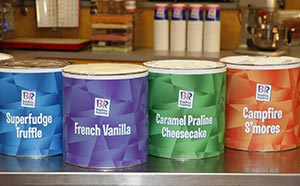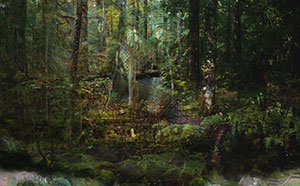It’s a December morning, and a blanket of snow has covered the University of Guelph’s Food Science building. Inside, Dr. Doug Goff, a world-renowned expert in the field of ice cream, illustrates the chemical composition of milk with wide gesticulations. His five-day ice cream technology course, the only such program in Canada (and one of just a handful in North America), has drawn a multi-generational group of about twenty professionals—an industry hodgepodge representing both large-scale processors like Nestlé and independent scoop shop entrepreneurs—who have paid around $1,900 a head and have come from as far away as Venezuela. To see them holding thick booklets filled with technical diagrams, one feels miles and months away from the dripping waffle cones Canadians will soon lap up at steamy barbecues. But frozen treats are typically brainstormed by people like these, in clinical settings like this, in the dead of winter—the time when production slows and companies start thinking about what flavours we’ll crave come the spring thaw.
This wasn’t always an issue; in the late nineteenth century, when ice cream was first sold commercially, the novelty of creamy frozen milk was enough. After the Second World War, when home refrigeration became widespread, the concoction took off as a domestic treat, but flavours remained simple: vanilla, chocolate, nearly neon strawberry, and, for the adventurous, tricoloured tubs of children’s-birthday-party-friendly Neapolitan. Clever marketers recognized the product’s experiential value: a treat consumed with family, at special occasions, during leisure time.
Baskin-Robbins’ 31 Flavours campaign, launched in 1953, kick-started a hunger for options, in step with postwar North America’s booming consumer culture. According to Goff, whose father worked at an ice cream plant in Nova Scotia for over forty years, this coincided with an industrial revolution: new blending tools, fruit syrups, and freezing technologies enabled producers to invent dream flavours. Customers could pick the kind that reflected their personal tastes and identities. This has informed marketing strategies; managers at Perry’s Ice Cream, a mid-size American company that sent one of its food technologists to Goff’s course, are acutely aware that how consumers choose their favourite flavour speaks volumes about how they self-identify.
With the changing times came changing tastes. Baskin-Robbins eventually discontinued its once-glamorous burgundy cherry and date nut flavours. Even old standbys like strawberry have declined—roughly 50 percent since its early heyday, estimates Mike Brown, senior product manager for Perry’s. Across the industry, nutty stalwarts like butter pecan and the East Coast favourite grapenut stood their ground. But even these varieties have no immunity to fickle preferences. While Canadians fifty-five and older prefer nutty flavours, younger people are increasingly choosing chunkier, more textured ice creams, like chocolate chip cookie dough and rocky road, according to an Angus Reid survey commissioned by Smucker’s last summer. A third wave of tastes has arrived.
Mean Sweets
A giant ice pop wreaks havoc on Manhattan
Dushan Milic
In 2005, Snapple attempted to market a new line of frozen desserts by breaking the Guinness World Record for largest freezer pop erected in a public square. On a hot summer day in New York, a giant crane raised a 7.5-metre, 16-ton ice pop from a refrigerated truck in Union Square. Immediately it began to melt, as frozen treats do. Strawberry-kiwi-flavoured liquid flooded the area, closing several blocks. “What was unsettling was that the fluid just kept coming,” Guinness Book of World Records representative Stuart Claxton told the Associated Press. “It [was] like oil,” added Nile Heffernan, a cyclist who took a bad fall after rounding a corner into the sugary slick: “I didn’t know what was on the road.” After the police and fire departments cleaned up the mess, Snapple decided to abandon its marketing gambit. Chances are sweltering New Yorkers would have much preferred a good old Freezie from the icebox.
—Amelia Schonbek
At the back of Goff’s classroom sat Alexa Fraser, a former fashion professional whose youth and enthusiasm distinguished her from her grey-haired classmates. After moving back to her hometown of St. Catharines, Ontario, just over a year ago, she sensed the growth of “something really great” in the city’s do-it-yourself arts scene. Always an adventurous eater, she built and decorated a bike-propelled ice cream cart at the beginning of last summer. She baked pies and mashed them into vanilla ice cream, formulated her own grapefruit champagne sorbet, and sourced local strawberries and rhubarb for one top-selling flavour. “I like weird stuff, ice cream with a lot going on,” she says. (Not all of her experiments went well: she threw out all of her dishcloths after a disastrous encounter with Parmesan cheese.)
Fraser’s ice cream, a “gourmet, natural product” that is “super-premium” (an industry buzzword for its dense, rich formulation) goes for $8 per pint and $4.50 per cone. “You can totally get cheaper ice cream from the store,” she says, “but my customers wouldn’t really be looking for that.” As cultural concerns about health, local eating, and quality have mounted, the industry has seen a rise in sales of gourmet ice creams like Fraser’s and, in the supermarket, flavours like “super-fruit” concoctions of pomegranate and acai. “For us, a lot of it is cachet,” says Brown. “People are looking for something unique.”
But while flavours change with the cultural tides, ice cream’s appeal goes beyond mere fads. “It’s one of the first products you consume as a kid, and one of the last products you consume in the old age home,” says Goff. “It’s associated with birthday parties, good times, the cottage; it has that aura. For me, it’s always been more than just a product.” More than identity, ice cream is tied to good memories.
It should come as no surprise, then, to find that one flavour has never gone out of style. Think about the first time you ate ice cream—about a picture-perfect sundae. It likely featured scoops of vanilla, piled high. The perennial favourite accounts for about 30 percent of the ice cream consumed in Canada, and Brown confirms that it’s Perry’s top seller. The runner-up? French vanilla.
This appeared in the June 2011 issue.




